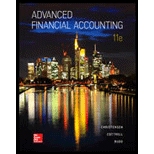
Advanced Financial Accounting
11th Edition
ISBN: 9780078025877
Author: Theodore E. Christensen, David M Cottrell, Cassy JH Budd Advanced Financial Accounting
Publisher: McGraw-Hill Education
expand_more
expand_more
format_list_bulleted
Concept explainers
Question
Chapter 2, Problem 2.2.2E
To determine
Concept Introduction:
The carrying amount means that the actual value or cost of the underlying asset while mentioned during the purchase. The carrying amount of assets is sometimes different from the value stated by market. Under the Equity method, the carrying amount is updated by the share of company income or losses and it decreases the carrying value by any dividends received on the shares.
To choose: The correct answer for the statement.
Expert Solution & Answer
Want to see the full answer?
Check out a sample textbook solution
Students have asked these similar questions
I want to this question answer for General accounting question not need ai solution
Hello tutor please given General accounting question answer do fast and properly explain all answer
During July, the production department of PrimeTech Manufacturing completed a number of units of a product and transferred them to finished goods. Of these transferred units, 45,000 were in process in the production department at the beginning of July, and 185,000 were started and completed in July. July's beginning inventory units were 35% complete with respect to materials and 55% complete with respect to labor. Compute the number of units transferred to finished goods.
Chapter 2 Solutions
Advanced Financial Accounting
Ch. 2 - What types of investments in common stock normally...Ch. 2 - Prob. 2.2AQCh. 2 - When is equity method reporting considered...Ch. 2 - Prob. 2.4QCh. 2 - Prob. 2.5QCh. 2 - Prob. 2.6QCh. 2 - Prob. 2.7QCh. 2 - Prob. 2.8QCh. 2 - How does carrying securities at fair value...Ch. 2 - How does the fully adjusted equity method differ...
Ch. 2 - Prob. 2.11QCh. 2 - What is the modified equity method? When might a...Ch. 2 - Prob. 2.13AQCh. 2 - Prob. 2.14QCh. 2 - Prob. 2.15QCh. 2 - Prob. 2.16QCh. 2 - Prob. 2.17QCh. 2 - How are a subsidiary’s dividend declarations...Ch. 2 - Prob. 2.19QCh. 2 - Give a definition of consolidated retained...Ch. 2 - Prob. 2.21QCh. 2 - Prob. 2.22QCh. 2 - Choice of Accounting Method Slanted Building...Ch. 2 - Prob. 2.2CCh. 2 - Prob. 2.3ACCh. 2 - Prob. 2.4CCh. 2 - Prob. 2.5CCh. 2 - Prob. 2.6CCh. 2 - Prob. 2.1.1ECh. 2 - Multiple-Choice Questions on Accounting for Equity...Ch. 2 - Prob. 2.1.3ECh. 2 - Prob. 2.1.4ECh. 2 - Prob. 2.1.5ECh. 2 - Prob. 2.1.6ECh. 2 - Multiple-Choice Questions on Intercorporate...Ch. 2 - Prob. 2.2.2ECh. 2 - Prob. 2.3.1ECh. 2 - Prob. 2.3.2ECh. 2 - Prob. 2.3.3ECh. 2 - Prob. 2.3.4ECh. 2 - Cost versus Equity Reporting Winston Corporation...Ch. 2 - Prob. 2.5ECh. 2 - Prob. 2.6ECh. 2 - Prob. 2.7ECh. 2 - Income Reporting Grandview Company purchased 40...Ch. 2 - Prob. 2.9ECh. 2 - Carrying an Investment at Fair Value versus Equity...Ch. 2 - Investee with Preferred Stock Outstanding Reden...Ch. 2 - Prob. 2.12AECh. 2 - Prob. 2.13AECh. 2 - Prob. 2.14ECh. 2 - Prob. 2.15ECh. 2 - Prob. 2.16ECh. 2 - Prob. 2.17ECh. 2 - Changes ¡n the Number of Shares Held Idle...Ch. 2 - Prob. 2.19PCh. 2 - Carried at Fair Value Journal Entries Marlow...Ch. 2 - Prob. 2.21APCh. 2 - Equity-Method Income Statement Wealthy...Ch. 2 - Consolidated Worksheet at End of the First Year of...Ch. 2 - Consolidated Worksheet at End of the Second Year...Ch. 2 - Prob. 2.25PCh. 2 - Prob. 2.26PCh. 2 - Prob. 2.27BPCh. 2 - Prob. 2.28BP
Knowledge Booster
Learn more about
Need a deep-dive on the concept behind this application? Look no further. Learn more about this topic, accounting and related others by exploring similar questions and additional content below.Similar questions
- Subject general accounting questionarrow_forwardPlease explain the solution to this general accounting problem using the correct accounting principles.arrow_forwardHarrison's Heavy Equipment, Inc., is a company that manufactures bulldozers. During the year, Harrison purchased $2,140,000 of direct materials and placed $1,890,000 worth of direct materials into production. Harrison's beginning balance in the Materials Inventory account was $320,000. What is the ending balance in Harrison's Materials Inventory account?arrow_forward
arrow_back_ios
SEE MORE QUESTIONS
arrow_forward_ios
Recommended textbooks for you
 Cornerstones of Financial AccountingAccountingISBN:9781337690881Author:Jay Rich, Jeff JonesPublisher:Cengage Learning
Cornerstones of Financial AccountingAccountingISBN:9781337690881Author:Jay Rich, Jeff JonesPublisher:Cengage Learning

Cornerstones of Financial Accounting
Accounting
ISBN:9781337690881
Author:Jay Rich, Jeff Jones
Publisher:Cengage Learning